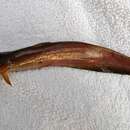fi
nimet breadcrumb-navigoinnissa


Heteropneustes microps és una espècie de peix de la família Heteropneustidae i de l'ordre dels siluriformes.
És un peix demersal i de clima tropical (22 °C-26 °C).[6][9]
Es troba a Àsia: Sri Lanka[10] i l'Índia.[11][12][13][14][15][6]
Heteropneustes microps és una espècie de peix de la família Heteropneustidae i de l'ordre dels siluriformes.
Heteropneustes microps is a species of airsac catfish possibly endemic to Sri Lanka, though records from India have been made. This species grows to a total length of 15.0 cm (5.9 in). This fish is a component of local commercial fisheries, and is found in the aquarium trade.
Heteropneustes microps is a species of airsac catfish possibly endemic to Sri Lanka, though records from India have been made. This species grows to a total length of 15.0 cm (5.9 in). This fish is a component of local commercial fisheries, and is found in the aquarium trade.
Heteropneustes microps es una especie de peces de la familia Heteropneustidae en el orden de los Siluriformes.
Los machos pueden llegar alcanzar los 15 cm de longitud total.[2][3]
Es ovíparo.
Es un pez de agua dulce y de clima tropical (22 °C-26 °C).
Se encuentran en Asia: Sri Lanka y la India.
Heteropneustes microps es una especie de peces de la familia Heteropneustidae en el orden de los Siluriformes.
Heteropneustes microps Heteropneustes generoko animalia da. Arrainen barruko Heteropneustidae familian sailkatzen da.
Heteropneustes microps Heteropneustes generoko animalia da. Arrainen barruko Heteropneustidae familian sailkatzen da.
Heteropneustes microps is een straalvinnige vissensoort uit de familie van zakkieuwigen (Heteropneustidae).[1] De wetenschappelijke naam van de soort is voor het eerst geldig gepubliceerd in 1864 door Günther.
Bronnen, noten en/of referentiesDługowąs azjatycki[3], workoskrzel azjatycki[3] (Heteropneustes fossilis, mylnie opisywany pod synonimiczną nazwą, jako odrębny gatunek, Heteropneustes microps[1][4]) – gatunek słodkowodnej ryby sumokształtnej z rodziny Heteropneustidae. Poławiany komercyjnie, hodowany w akwakulturze, pielęgnowany w akwariach[5]. W Indiach jego mięso jest uważane za posiadające właściwości lecznicze. W Kalkucie żywe ryby z tego gatunku sprzedawane są w dużych ilościach[2].
Jest gatunkiem szeroko rozprzestrzenionym w południowej Azji (Pakistan, Indie, Sri Lanka, Nepal, Bangladesz, Mjanma, Tajlandia i Laos). W wielu miejscach został introdukowany (Iran, Irak)[2]. Zasiedla wody słodkie, rzadziej słonawe.
Na wolności osiąga długość około 50 cm, maksymalnie 70 cm[6], natomiast w niewoli rzadko przekracza 30 cm. Jest to ryba bardzo agresywna i napastliwa zarówno dla przedstawicieli swojego, jak i innych gatunków. Nie należy jej łączyć z mniejszymi rybami (mogą być pożarte) lub z innymi rybami z własnego gatunku (istnieje ryzyko agresji wewnątrzgatunkowej).
Bloch opisał ten gatunek w 1794 pod nazwą Silurus fossilis. Kilku innych autorów opisywało go później pod innymi nazwami, m.in. Saccobranchus microps, który do niedawna był uznawany za odrębny gatunek, przeniesiony do rodzaju Heteropneustes jako H. microps. Ferraris[7] w 2007 wykazał, że Saccobranchus microps jest synonimem nazwy Heteropneustes fossilis, co umknęło uwadze wielu autorów, również w ITIS i FishBase[4]. Stanowisko Ferrarisa zostało potwierdzone w pracach Kottelata (2013) i Ratmuangkhwanga (2014)[8].
Zbiornik powinien być duży (o długości min. 100 cm), szczelnie przykryty, gdyż ryba może wydostać się z akwarium. Długowąs azjatycki jest aktywny głównie o zmierzchu i nocą. Wymaga drobnoziarnistego miałkiego podłoża, niezawierającego żadnych ostrych krawędzi. W jasnym zbiorniku nie czuje się dobrze. Akwarium powinno być gęsto obsadzone roślinami oraz oferować dużo kryjówek np. z korzeni i kamieni.
Woda powinna mieć temperaturę 15–28 °C, pH między 6,6 a 7,6, miękka do średnio twardej[3]. Długowąsy azjatyckie są żarłoczne i wszystkożerne, zjadają każdy napotkany pokarm. Dorosłe potrafią zjeść nawet dużą rybę, jeżeli ta znajduje się nocą w pobliżu dna.
Podczas wyławiania ryby zalecana jest szczególna ostrożność, gdyż można zranić rękę kolcami umiejscowionymi na płetwach piersiowych. U uczulonych ludzi ukłucie powoduje, że dochodzi do obrzęku.
Długowąsy azjatyckie są zdolne do rozmnażania, gdy osiągną długość około 15 cm. Umieszczone w oddzielnym akwarium łatwo przystępują do tarła. Potrzebują jednak dość obszernego i dobrze napowietrzonego zbiornika, w którym połowa wody musi być wymieniona na świeżą. Składają ikrę na żwirowym podłożu, najczęściej w sąsiedztwie roślin.
Samce przygotowują się do tarła już w godzinach popołudniowych, a w godzinach wieczornych formują ciało w kształt litery "U". Obok samca przesuwa się powoli samica składając ikrę. Większe samice potrafią złożyć w kilku miejscach akwarium nawet 6 000 jaj. Do rozwoju ikry potrzeba bardzo silnego napowietrzania. Larwy zaczynają się wylęgać po około 24 godzinach. Przez 4 do 5 dni jako pożywienie wystarcza im zawartość woreczka żółtkowego. Po tym czasie narybek rozpływa się w poszukiwaniu pokarmu. Pokarmem w początkowym okresie karmienia jest żywy mikroplankton. Narybek wymaga dobrego karmienia, mocnego filtrowania i napowietrzania oraz częstej podmiany wody. Kondycja i wzrost zależy od tego, ile pokarmu można zagwarantować stale głodnym długowąsom.
Długowąs azjatycki, workoskrzel azjatycki (Heteropneustes fossilis, mylnie opisywany pod synonimiczną nazwą, jako odrębny gatunek, Heteropneustes microps) – gatunek słodkowodnej ryby sumokształtnej z rodziny Heteropneustidae. Poławiany komercyjnie, hodowany w akwakulturze, pielęgnowany w akwariach. W Indiach jego mięso jest uważane za posiadające właściwości lecznicze. W Kalkucie żywe ryby z tego gatunku sprzedawane są w dużych ilościach.
Heteropneustes microps é uma espécie de peixe da família Heteropneustidae.
É endémica do Sri Lanka.
Heteropneustes microps é uma espécie de peixe da família Heteropneustidae.
É endémica do Sri Lanka.
Heteropneustes microps là một loài cá da trơn túi khí có lẽ đặc hữu Sri Lanka, dù có một số ghi nhận ở Ấn Độ. Loài này dài 15,0 xentimét (5,9 in) theo TL. Loài cá này là một thủy sản thương mại của địa phương cũng như được nuôi làm cảnh.
Heteropneustes microps là một loài cá da trơn túi khí có lẽ đặc hữu Sri Lanka, dù có một số ghi nhận ở Ấn Độ. Loài này dài 15,0 xentimét (5,9 in) theo TL. Loài cá này là một thủy sản thương mại của địa phương cũng như được nuôi làm cảnh.
小眼囊鰓鯰,為輻鰭魚綱鯰形目囊鰓鯰科的其中一種,為熱帶淡水魚,分布於亞洲斯里蘭卡淡水、半鹹水流域,體長可達15公分,棲息在底層水域,屬雜食性,生活習性不明,可做為食用魚及觀賞魚。